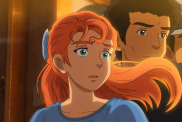Now available on VOD

Cast:
Carmen Beato as Patricia
Francisco Barreiro as Alfredo
Alan Chavez as Julian
Paulina Gaitan as Sabina
Directed by Jorge Michel Grau
Review:
In the film’s captivating opening sequence, a disoriented man in bloodstained clothing wanders through an outdoor shopping mall. He becomes transfixed by the sight of a store window mannequin and attempts to touch it, his hand blocked by the glass. He’s rushed off by a store employee and collapses dead a few moments later.
We learn that this man was the patriarch of a family who regularly practices something they call “the ritual,” which is the procuring, preparation and eating of other human beings.
With their hunter now gone, the remaining family members-the mother and three teenage children- scramble desperately to keep their insular group together. At one point early on, we see them standing in front of a wall of clocks the father had repaired, suggesting (and rightfully so) that time is running out for the fractured family.
The two sons, Julian and Alfredo, clash over who will now become the leader while mother Patricia and daughter Sabina act on their own ideas of what needs to happen next, resulting in a series of catastrophic decisions that culminates in a gruesome climax from which no one escapes unscathed.
In the midst of the downward spiral, hidden feelings come to the surface as attempts are made to capture victims. An incestuous attraction between Julian and Sabina is suggested and Alfredo’s homosexual urges are awakened as he stalks a potential victim in a dance club catering to young gay men.
In a nod to the real life Jeffrey Dahmer case, Alfredo brings his intended victim home from the club but the young man escapes before being killed and alerts the police, securing the beginning of the end for the cannibalistic family.
We Are What We Are adopts a refreshingly grim, realistic and uncompromising approach to its story, naturally separating the film by miles from such comedic progenitors as Motel Hell and Parents. What threatens this serious tone but thankfully doesn’t derail the film are several inappropriate moments of black comedy centered around a morgue scene (an homage to fellow Mexican director Guillermo Del Toro’s 1993 feature debut Cronos) and some scenes depicting a pair of incompetent police detectives looking to make names for themselves. Grau teeters on the brink a couple of times but ultimately manages to keep his disturbing tight rope act on course.
By contrast, look at how the grossly inappropriate use of ridiculously lighthearted music during the otherwise incredibly intense cave sequence in Ravenous deals that particular cannibal film a crippling tonal blow that in my opinion it never recovers from despite some gripping subsequent scenes.
Another refreshing aspect of the film is Grau’s rather non-traditional choice of setting. He takes his entry in the subgenre out of the very influential Tobe Hooper backwoods, the Wes Craven/Alexandre Aja desert and the Rugerro Deodato/Umberto Lenzi/European horror jungle and puts it squarely behind the closed doors of a modern urban household far more successfully than such films as Pete Walker’s Frightmare.
Comparisons have been made in some reviews between We Are What We Are and Swedish director’s Tomas Alfredson’s 2008 horror genre milestone Let the Right One In. This is an inaccurate parallel but it brings up an interesting contrast.
While Let the Right One In is ultimately the moving story of a young victimized boy finding a real emotional connection in a literal and figurative cold world, with We Are What We Are Grau makes a bold attempt at making a film with no sympathetic or likable characters, resulting in a much more clinical viewing experience. With this rather remote approach and its Bernard Herrmann-like musical score, one could easily imagine something very close to We Are What We Are being the result if Martin Scorsese made a cannibal film.
Director Michael J. Bassett recently attempted a very similar feat with Wilderness, about a group of violent teenage criminals trapped on an island fighting for their life against a mysterious assailant, scripted by Black Death screenwriter Dario Poloni. Both films strive to be tense and gripping with a cast of characters ranging from generally unlikable to absolutely repellent. While Wilderness doesn’t fully come together and fails despite some well done sequences, We Are What We Are succeeds.
All in all, We Are What We Are is a bold, auspicious feature directing debut with a strong, dark vision from writer/director Jorge Michel Grau highlighted by excellent cinematography from Santiago Sanchez, who shot a number of Grau’s short films.
With the film having made a critically acclaimed run through the world genre film festival circuit and now in American release, will we see a boom in Mexican horror film production like we did in France after the international success of Alexandre Aja’s High Tension? Time will tell but regardless, Jorge Michel Grau is definitely a talent to watch.
Note: For an enjoyable and well-informed rant on the entertainment industry’s obsession with “sympatheticâ characters, seek out David J. Schow’s 1995 article “SYMPS.”










